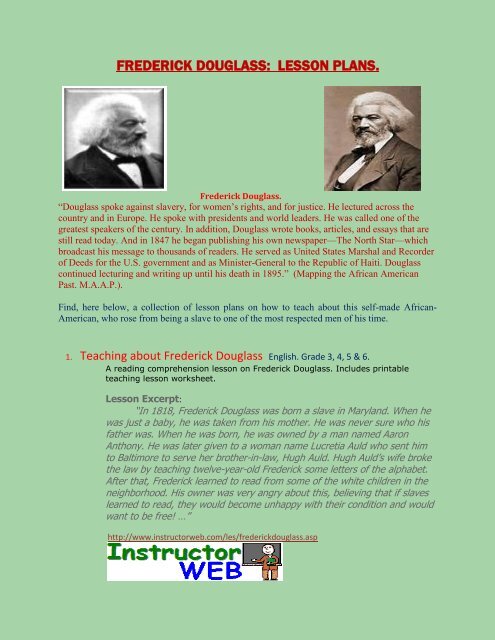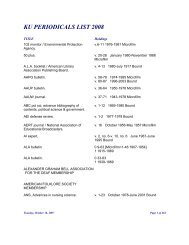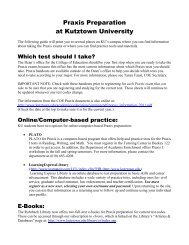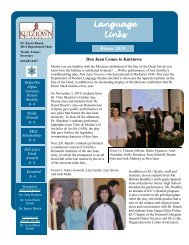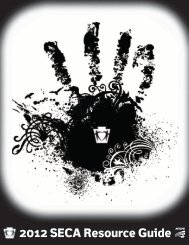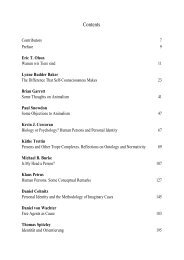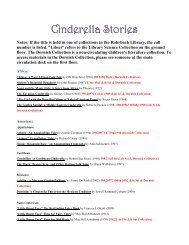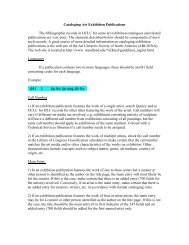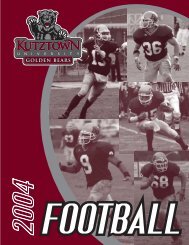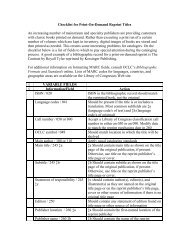FREDERICK DOUGLASS: LESSON PLANS. - Kutztown University
FREDERICK DOUGLASS: LESSON PLANS. - Kutztown University
FREDERICK DOUGLASS: LESSON PLANS. - Kutztown University
You also want an ePaper? Increase the reach of your titles
YUMPU automatically turns print PDFs into web optimized ePapers that Google loves.
<strong>FREDERICK</strong> <strong>DOUGLASS</strong>: <strong>LESSON</strong> <strong>PLANS</strong>.<br />
Frederick Douglass.<br />
“Douglass spoke against slavery, for women’s rights, and for justice. He lectured across the<br />
country and in Europe. He spoke with presidents and world leaders. He was called one of the<br />
greatest speakers of the century. In addition, Douglass wrote books, articles, and essays that are<br />
still read today. And in 1847 he began publishing his own newspaper—The North Star—which<br />
broadcast his message to thousands of readers. He served as United States Marshal and Recorder<br />
of Deeds for the U.S. government and as Minister-General to the Republic of Haiti. Douglass<br />
continued lecturing and writing up until his death in 1895.” (Mapping the African American<br />
Past. M.A.A.P.).<br />
Find, here below, a collection of lesson plans on how to teach about this self-made African-<br />
American, who rose from being a slave to one of the most respected men of his time.<br />
1. Teaching about Frederick Douglass English. Grade 3, 4, 5 & 6.<br />
A reading comprehension lesson on Frederick Douglass. Includes printable<br />
teaching lesson worksheet.<br />
Lesson Excerpt:<br />
“In 1818, Frederick Douglass was born a slave in Maryland. When he<br />
was just a baby, he was taken from his mother. He was never sure who his<br />
father was. When he was born, he was owned by a man named Aaron<br />
Anthony. He was later given to a woman name Lucretia Auld who sent him<br />
to Baltimore to serve her brother-in-law, Hugh Auld. Hugh Auld’s wife broke<br />
the law by teaching twelve-year-old Frederick some letters of the alphabet.<br />
After that, Frederick learned to read from some of the white children in the<br />
neighborhood. His owner was very angry about this, believing that if slaves<br />
learned to read, they would become unhappy with their condition and would<br />
want to be free! …”<br />
http://www.instructorweb.com/les/frederickdouglass.asp
2. Narrative of the life of Frederick Douglass :<br />
ENGLISH, GRADE 9<br />
This lesson plan is designed to encourage the student to read purposefully, learn<br />
reading strategies, and develop the student’s Expository Reading strategies for<br />
improving his critical thinking skills.<br />
The goal of the lesson plan is to introduce and develop Expository Reading strategies,<br />
expand technologies in academics, and implement the CSTP and OUSD (ELA/ELD)<br />
standards including:<br />
Writing Strategies<br />
Literary Response<br />
Critical Thinking<br />
http://urbandreams.ousd.k12.ca.us/lessonplans/frederickdouglass/index.<br />
3. Teacher Resource File [Bibliography] [Lesson Plans] [Other<br />
Resources] [Essays & Criticism]<br />
HISTORY, LANGUAGE, LITERATURE AND ARTS. GRADE K-12<br />
http://falcon.jmu.edu/~ramseyil/douglass.htm<br />
http://edsitement.neh.gov/view_lesson_plan.asp?id=594<br />
In this website is an array of lesson plans for various subjects suitably designed to cater for the<br />
special and specific needs of learners in each grade K-12<br />
4. Background: Frederick Augustus Washington Bailey.<br />
ENGLISH / HISTORY GRADE 5-9<br />
In approximately 7-10 class periods, students will be able to demonstrate their personal<br />
beliefs by creating a class newspaper, identify their personal qualities and the contributions<br />
for which they would like to be remembered for and identify at least two contributions<br />
made by Frederick Douglass and write them in their reflective journals among others.<br />
http://teacherlink.ed.usu.edu/tlresources/units/Byrnes-famous/douglass.html<br />
5. From Courage to Freedom: Frederick Douglass's 1845<br />
Autobiography<br />
The Narrative in itself is remarkable for the views on slavery and slaveholders that<br />
Douglass bravely presents.
HISTORY GRADES 9 – 12<br />
Frederick Douglass's 1845 narrative of his life is a profile in both moral and<br />
physical courage. In the narrative Douglass openly illustrates and attacks the<br />
misuse of Christianity as a defense of slavery. He also reveals the turning point of<br />
his life: his spirited physical defense of himself against the blows of a white<br />
"slave-breaker."<br />
http://edsitement.neh.gov/view_lesson_plan.asp?id=594<br />
6. What Will the Teacher / Students Do?<br />
Get a 3 week (Daily) Pdf materials for teaching Narrative of the Life of Frederick<br />
Douglass.<br />
Also included are evaluation and testing methods, video clips and class projects.<br />
http://urbandreams.ousd.k12.ca.us/lessonplans/frederickdouglass/activities.html<br />
ENGLISH LEVEL 9<br />
7. Narrative of the Life of Frederick Douglass, an American Slave,<br />
Written by Himself | Lesson Plan Materials<br />
eNotes offers a number of lesson plans from various hand-picked providers.<br />
A purchase of any one or more of the items below includes access to the eNotes and<br />
Salem on Literature for Narrative of the Life of Frederick Douglass, an American Slave,<br />
Written by Himself.<br />
http://www.enotes.com/narrative-life-lesson/<br />
8. Frederick Douglass.<br />
ENGLISH<br />
Lesson plans and teaching resources: Biography and<br />
Background:<br />
A thorough unit plan, including activities, quizzes, and tests as well as the<br />
complete eNotes.<br />
http://www.webenglishteacher.com/douglass.html
9. American Writers: Frederick Douglass Video Lesson Plan:<br />
Use the themes, questions and video clips in this website to teach and learn with<br />
portions of C-SPAN's American Writers program featuring Frederick Douglass and<br />
Narrative of the Life of Frederick Douglass.<br />
http://www.americanwriters.org/classroom/videolesson/vlp11_douglass.asp<br />
10. Frederick Douglass: The Reality of Slavery:<br />
ENGLISH<br />
Click this link to access a lesson plan on how to teach about literary devices like<br />
imagery, repetition and rhetoric appeals in a grammar class using Frederick Douglass’<br />
Narrative.<br />
http://edsitement.neh.gov/lesson_images/lesson598/Essays-Douglass.pdf<br />
11. Teaching Materials For, Narrative of Frederick Douglass by<br />
Frederick Douglass:<br />
Online books and movies on the Narrative of the life of Frederick Douglass<br />
http://www.tpet.com/categories.asp?cid=168&c=35741<br />
12. Frederick Douglass: If There Is No Struggle, There Is No Progress<br />
HISTORY<br />
The aim of this lesson is to explore the relevance of Frederick Douglass’ method of<br />
resistance in today’s society.<br />
http://maap.columbia.edu/lesson/2.html<br />
13. Frederick Douglass: If There Is No Struggle, There Is No Progress -<br />
4th Grade Adaptation<br />
Aim:<br />
In analyzing the relevance of Frederick Douglass’ method of resistance in the current society, the<br />
fourth grade students will be able to also explore the natural, political and moral grounds for<br />
resistance to evil.<br />
http://maap.columbia.edu/lesson/20.html<br />
14. Frederick Douglass Lesson study: A Man and His Times<br />
HISTORY GRADE 8<br />
This Frederick Douglass lesson study involves Douglass’ speech; “The Meaning of<br />
July Fourth for the Negro” delivered at Rochester, New York, July 5th, 1852.<br />
“…the rare qualities of an extraordinary man in extraordinary times…” are examined.<br />
http://www.teachingamericanhistory.us/lesson_plans/group_5/index.html
15. National Park Service Teaching with Museum Collections Lesson<br />
Plan. Frederick Douglass' Hat<br />
HISTORY<br />
Get a 45 minute middle school lesson plan that demonstrates how objects can serve<br />
as primary sources for learning about an individual, his society and the cultural<br />
values of the time.<br />
http://www.nps.gov/history/museum/tmc/docs/FRDO_hatLessonplan.pdf<br />
16. Human Heritage: A World History<br />
HISTORY<br />
After the students have read about the civil war in America and the issue of slavery,<br />
the life of Frederick Douglass would be their next best step. They will use information<br />
from the American Visionaries: Frederick Douglass Web site to learn about Frederick Douglass.<br />
Students will read about his early life, his role as an orator against slavery, his many public<br />
offices, and his work for women's rights. Students will then answer questions and apply this<br />
information by writing an imagined conversation that they would have with Frederick Douglass<br />
if they could travel back to 1889.<br />
http://www.glencoe.com/sec/socialstudies/worldhistory/hh2004/content.php4/1337/5<br />
17. From Courage to Freedom: Frederick Douglass’s 1845<br />
Autobiography.<br />
In these lesson plans, you will be guided by the questions:<br />
How does Frederick Douglass's skilled use of language paint a realistic portrait of<br />
slavery?<br />
How successful is Douglass in persuading the reader of the evils that slavery<br />
inflicts on both slave and slaveholder alike?<br />
http://edsitement.neh.gov/view_lesson_plan.asp?id=594<br />
18. Brooklyn in the Civil War:<br />
These lesson plans can be adapted to suit students in 4th-12th grades. They are divided into the<br />
four thematic units featured on the Web site: daily life, slavery, war and soldiers' lives, and<br />
women. Each lesson focuses on one or more primary source documents including letters, news<br />
articles and advertisements from the Brooklyn Daily Eagle, photographs, sketches, and poems.<br />
Students learn how to "read" original documents and differentiate between fact and opinion.<br />
http://www.brooklynpubliclibrary.org/civilwar/cw_lessonplans.html<br />
19. Frederick Douglass' Role in the Abolition of Slavery<br />
HISTORY AND SOCIAL SCIENCE GRADE 11
This lesson examines sources on Frederick Douglass' role in the abolition of slavery, identifies<br />
Douglass' personal traits, speeches, and associations in relation to his cause and hypothesizes<br />
how these different aspects of Douglass' life contributed to the successful abolition of slavery.<br />
One purpose of this lesson is to bring technology into the classroom while teaching part of one of<br />
the SOLs. The other purpose of this lesson is to take a closer look at one of the key players in the<br />
abolition movement.<br />
http://www.knowledge.state.va.us/cgi-bin/lesview.cgi?idl=198<br />
20. For Teachers: Douglass in the Classroom<br />
Browse though a collection of lesson plans prepared by four Graduate students of the <strong>University</strong><br />
of Rochester’s Warner School of Education.<br />
Topics covered include Abolitionism Divided, The Abolitionist Movement, The concepts of<br />
Citizenship, Creating Change through a Newspaper, defending Slavery, and democratic Values<br />
among others.<br />
http://www.lib.rochester.edu/index.cfm?page=2885


